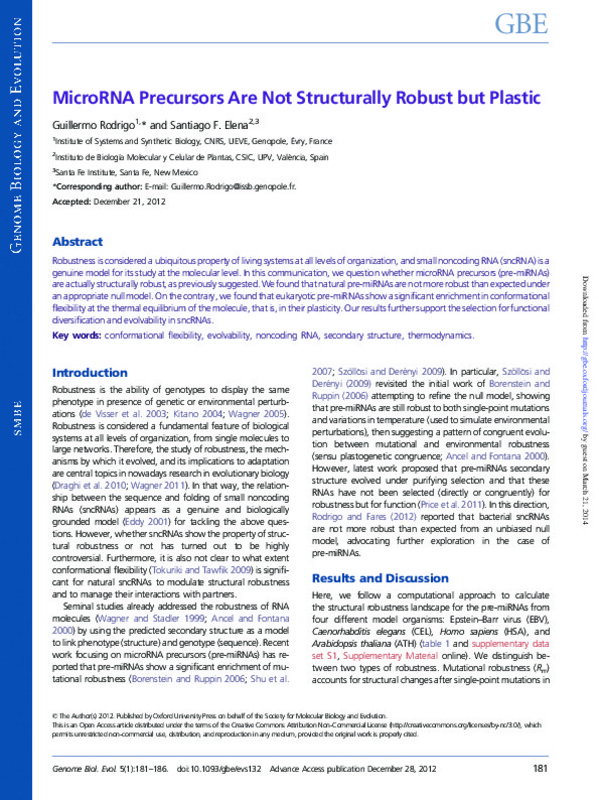Ancel, L. W., & Fontana, W. (2000). Plasticity, evolvability, and modularity in RNA. Journal of Experimental Zoology, 288(3), 242-283. doi:10.1002/1097-010x(20001015)288:3<242::aid-jez5>3.0.co;2-o
Borenstein, E., & Ruppin, E. (2006). Direct evolution of genetic robustness in microRNA. Proceedings of the National Academy of Sciences, 103(17), 6593-6598. doi:10.1073/pnas.0510600103
CLOTE, P. (2005). Structural RNA has lower folding energy than random RNA of the same dinucleotide frequency. RNA, 11(5), 578-591. doi:10.1261/rna.7220505
[+]
Ancel, L. W., & Fontana, W. (2000). Plasticity, evolvability, and modularity in RNA. Journal of Experimental Zoology, 288(3), 242-283. doi:10.1002/1097-010x(20001015)288:3<242::aid-jez5>3.0.co;2-o
Borenstein, E., & Ruppin, E. (2006). Direct evolution of genetic robustness in microRNA. Proceedings of the National Academy of Sciences, 103(17), 6593-6598. doi:10.1073/pnas.0510600103
CLOTE, P. (2005). Structural RNA has lower folding energy than random RNA of the same dinucleotide frequency. RNA, 11(5), 578-591. doi:10.1261/rna.7220505
Draghi, J. A., Parsons, T. L., Wagner, G. P., & Plotkin, J. B. (2010). Mutational robustness can facilitate adaptation. Nature, 463(7279), 353-355. doi:10.1038/nature08694
Eddy, S. R. (2001). Non–coding RNA genes and the modern RNA world. Nature Reviews Genetics, 2(12), 919-929. doi:10.1038/35103511
Fang, X.-W., Golden, B. L., Littrell, K., Shelton, V., Thiyagarajan, P., Pan, T., & Sosnick, T. R. (2001). The thermodynamic origin of the stability of a thermophilic ribozyme. Proceedings of the National Academy of Sciences, 98(8), 4355-4360. doi:10.1073/pnas.071050698
Gruber, A. R., Bernhart, S. H., Hofacker, I. L., & Washietl, S. (2008). Strategies for measuring evolutionary conservation of RNA secondary structures. BMC Bioinformatics, 9(1), 122. doi:10.1186/1471-2105-9-122
Hofacker, I. L., Fontana, W., Stadler, P. F., Bonhoeffer, L. S., Tacker, M., & Schuster, P. (1994). Fast folding and comparison of RNA secondary structures. Monatshefte f�r Chemie Chemical Monthly, 125(2), 167-188. doi:10.1007/bf00818163
Kitano, H. (2004). Biological robustness. Nature Reviews Genetics, 5(11), 826-837. doi:10.1038/nrg1471
Kozomara, A., & Griffiths-Jones, S. (2010). miRBase: integrating microRNA annotation and deep-sequencing data. Nucleic Acids Research, 39(Database), D152-D157. doi:10.1093/nar/gkq1027
Layton, D. M. (2005). A statistical analysis of RNA folding algorithms through thermodynamic parameter perturbation. Nucleic Acids Research, 33(2), 519-524. doi:10.1093/nar/gkh983
Lee, Y. (2002). MicroRNA maturation: stepwise processing and subcellular localization. The EMBO Journal, 21(17), 4663-4670. doi:10.1093/emboj/cdf476
Lynch, M., & Conery, J. S. (2003). The Origins of Genome Complexity. Science, 302(5649), 1401-1404. doi:10.1126/science.1089370
McCaskill, J. S. (1990). The equilibrium partition function and base pair binding probabilities for RNA secondary structure. Biopolymers, 29(6-7), 1105-1119. doi:10.1002/bip.360290621
Neilsen, C. T., Goodall, G. J., & Bracken, C. P. (2012). IsomiRs – the overlooked repertoire in the dynamic microRNAome. Trends in Genetics, 28(11), 544-549. doi:10.1016/j.tig.2012.07.005
Nozawa, M., Miura, S., & Nei, M. (2010). Origins and Evolution of MicroRNA Genes in Drosophila Species. Genome Biology and Evolution, 2, 180-189. doi:10.1093/gbe/evq009
Orr, H. A. (2005). The genetic theory of adaptation: a brief history. Nature Reviews Genetics, 6(2), 119-127. doi:10.1038/nrg1523
Parisien, M., Cruz, J. A., Westhof, E., & Major, F. (2009). New metrics for comparing and assessing discrepancies between RNA 3D structures and models. RNA, 15(10), 1875-1885. doi:10.1261/rna.1700409
Price, N., Cartwright, R. A., Sabath, N., Graur, D., & Azevedo, R. B. R. (2011). Neutral Evolution of Robustness in Drosophila microRNA Precursors. Molecular Biology and Evolution, 28(7), 2115-2123. doi:10.1093/molbev/msr029
Rodrigo, G., & Fares, M. A. (2012). Describing the structural robustness landscape of bacterial small RNAs. BMC Evolutionary Biology, 12(1), 52. doi:10.1186/1471-2148-12-52
Sanjuán, R., Cuevas, J. M., Furió, V., Holmes, E. C., & Moya, A. (2007). Selection for Robustness in Mutagenized RNA Viruses. PLoS Genetics, 3(6), e93. doi:10.1371/journal.pgen.0030093
Shu, W., Bo, X., Ni, M., Zheng, Z., & Wang, S. (2007). In silico genetic robustness analysis of microRNA secondary structures: potential evidence of congruent evolution in microRNA. BMC Evolutionary Biology, 7(1), 223. doi:10.1186/1471-2148-7-223
Starega-Roslan, J., Krol, J., Koscianska, E., Kozlowski, P., Szlachcic, W. J., Sobczak, K., & Krzyzosiak, W. J. (2010). Structural basis of microRNA length variety. Nucleic Acids Research, 39(1), 257-268. doi:10.1093/nar/gkq727
Szollosi, G. J., & Derenyi, I. (2009). Congruent Evolution of Genetic and Environmental Robustness in Micro-RNA. Molecular Biology and Evolution, 26(4), 867-874. doi:10.1093/molbev/msp008
Tokuriki, N., & Tawfik, D. S. (2009). Protein Dynamism and Evolvability. Science, 324(5924), 203-207. doi:10.1126/science.1169375
Wagner, A. (2012). The role of robustness in phenotypic adaptation and innovation. Proceedings of the Royal Society B: Biological Sciences, 279(1732), 1249-1258. doi:10.1098/rspb.2011.2293
Wagner, A., & Stadler, P. F. (1999). Viral RNA and evolved mutational robustness. Journal of Experimental Zoology, 285(2), 119-127. doi:10.1002/(sici)1097-010x(19990815)285:2<119::aid-jez4>3.0.co;2-d
Wuchty, S., Fontana, W., Hofacker, I. L., & Schuster, P. (1999). Complete suboptimal folding of RNA and the stability of secondary structures. Biopolymers, 49(2), 145-165. doi:10.1002/(sici)1097-0282(199902)49:2<145::aid-bip4>3.0.co;2-g
[-]








